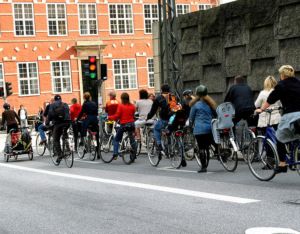Opinion
Englishman in Nyhavn: How to not crash your bike in Copenhagen
Jack Gardner
This article is more than 5 years old.

Left lane bellend (LLB) alert! (Photo: Mikael Colville-Andersen)
Recently, I had a bike crash that was entirely my own fault. Therefore, I have decided to publish a Comprehensive Catalogue to Cycling Carefully in Copenhagen (CCCCC).
1/ Stay in the cycle lane
Since you ask, my high-speed disaster occurred after straying from the well-demarcated, physically-separated cycle lane onto the road.
Why did I do this? Was it a thrilling attempt to generate endorphins? Or a Psychiatric Delusionary Episode (PDE) in which the subject believes they have become vehicular? We may never know, although it will be debated by scholars for centuries.
A bus appeared behind me. Panicking, I sped up in the hope I might mount the kerb and jump back on. The sheer force of my legs propelled me from anywhere between 15-170 km/h.
I jumped. However, it had been raining. “In Copenhagen?!” I hear you cry –YES, don’t interrupt me. Down I went, sliding forward on what felt like the World’s Shittiest Slip-And-Slide (WSSAS). My body was unscathed. My jeans took the damage.
This experience remains hard to discuss. And, yes, I am weeping as I write this because … those jeans were Levis. One minute they were there … durable. The next … gone. It’s my fault. Oh God – It’s All My Fault (OGIAMF).
2/ Stay in your lane
Once on the cycle path, generally stick to the right-hand side. The left hand is only used for overtaking and Really Quick Legends [RQL], such as myself I guess.
But from someone who has a reputation here as a Left Lane Legend [LLL/ Triple L], I just want to say there is absolutely no shame in spending your entire journey in the right-hand lane, with all your other slow pathetic baby friends.
When overtaking, you might think it’s a good idea to check behind to see if anyone is approaching to avoid crashing. However, Copenhagenites are averse to such behaviour. Therefore, in order to Be A True Copenhagener Or Copenhagen King [BATCOCK™], it is crucial that you blindly and violently swerve into the fast lane, preferably wearing noise-cancelling headphones.
3/ Hand signals
Judging by how much they do it, indicating is the single most Danish thing ever – more so than Liquorice, Marzipan or Elves [LiqME] combined. For any southern Europeans reading: indicating is when a vehicle operator signals to other road-users that they intend to change direction.
The most uniquely Danish hand signal comes whenever they want to stop. At this point, you raise either arm with a flat hand level with your head, as if giving an awkward high-five. Keep that elbow tucked though. I once saw someone extend their hand fully above their head and, while I admired their commitment, they looked like they were giving a poorly judged, fly-by Nazi salute.
4/ Infraction protocol
This is the most important rule. Obviously, given that there are over 12 billion cyclists in Copenhagen, you will constantly see people making errors. Your reaction is critical.
Just after you have passed them, you MUST look down and shake your head – in as dismissive manner as possible. An Exasperatedly Raised Eyebrow [ERE] is a nice touch, but not essential.
What is essential is that the guilty party feels your disgust. After all, if no-one sees a Danish tree fall in a Danish forest, does it fall Danishly? Likewise, if you shake your head at a newcomer making an innocent mistake, and no-one sees you do it – are you still a patronising prick?
It Doesn’t Even Bear Thinking About Really, So Exhibit Headshaking Obviously, Loyal Enforcers! (IDEBTARSEHOLE).

About
Jack Gardner
Jack escaped Brexit Britain in October 2019 to forge a new life in Copenhagen. In this column, he outlines the challenges expats face when integrating into Danish life. Jack (jacksgard@gmail.com) co-hosts the comedy podcast ‘Butterflies on the Wheel’, which is available on all major podcasting platforms










































